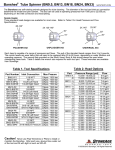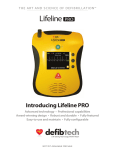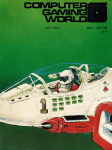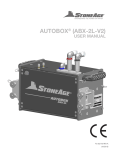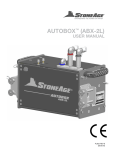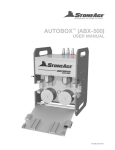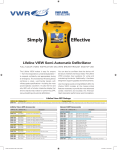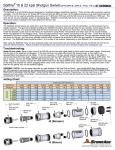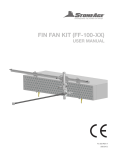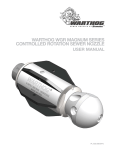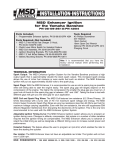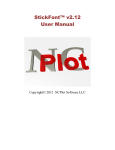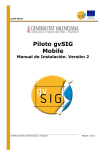Download Banshee BN27-40K - User Manual
Transcript
Banshee® 40 kpsi Tube Spinner (BN13, BN18, BN27) SAPATENTS.COM The Banshees are self-rotating swivels designed for tube cleaning. The diameter of the tool and inlet nut connection determine the model and part number. The tool can be used at operating pressures from 25,000 psi to 40,000 psi, depending on the inlet connection and head jetting. Nozzle Heads: Two standard head designs are available for all sizes. Refer to Table 2 for Head Jetting and Flow Specifications. 2X 110° 2X 85° 2X 140° 30° 15° 50° POLISHER 442 UNPLUGGER 443 Each head is capable of a range of pressures and flows. The pull of the standard heads ranges from 3.5 to 4 pounds. The heads have threaded replaceable sapphire nozzle inserts; use loctite 680 to retain and seal them. The nozzles seat against the bottom of the port; screw them in until they stop. To remove worn nozzle inserts, heat the head with a propane torch for about a minute; just enough to break down the loctite. The same head is used for both the C and D patterns; just the orifices can be changed to match either flow rate. All of the nozzle inserts use a 5/64" allen wrench. The wrench flats provided on the Shaft, Head, Body & Nut should always be used when maintaining these tools. Table 3 details the wrench size required for each tool part. These wrenches are available from StoneAge. Table 2- Head Options Table 1- Tool Specifications Inlet Max Part Number Connection Presure BN13-H4L BN13-H6L BN18-H6L BN18-HM14L BN27-H9L BN27-HM14L 1/4-28 L.H. High Pressure 3/8-24 L.H. High Pressure 40,000 psi (2800 bar) 40,000 psi (2800 bar) 3/8-24 L.H. High Pressure M14x1.5 L.H. High Pressure 40,000 psi (2800 bar) 40,000 psi (2800 bar) 9/16-18 L.H. High Pressure M14x1.5 L.H. High Pressure 40,000 psi (2800 bar) 40,000 psi (2800 bar) Caution! Never use Pipe Wrenches or Pliers to install or maintain the Banshee. After each use, always blow water out of the tool and fill with light oil such as WD-40. Part Front Jets Back Jets Flow BN13 442-C BN13 442-D 2 x .014 2 X .010 2 x .015 2 X .014 5.5-6 gpm 4.5-5 gpm BN13 443-C BN13 443-D 3 x .010 3 x .009 2 x .016 2 x .015 5.5-6 gpm 4.5-5 gpm BN18 442-A BN18 442-B BN18 442-C BN18 442-D 2 x .020 2 x .018 2 x .015 2 x .010 2 x .017 2 x .017 2 x .015 2 x .014 8-8.5 gpm 7-7.5 gpm 6-6.5 gpm 5-5.5 gpm BN18 443-A BN18 443 B BN18 443-C BN18 443-D 3 x .014 3 x .013 3 x .011 3 x .009 2 x .020 2 x .019 2 x .016 2 x .014 8-8.5 gpm 7-7.5 gpm 6-6.5 gpm 5-5.5 gpm BN27 442-A BN27 442-B BN27 442-C BN27 442-D 2 x .018 2 x .015 2 x .011 2 x .009 2 x .018 2 x .016 2 x .015 2 x .013 8-8.5 gpm 7-7.5 gpm 6-6.5 gpm 5-5.5 gpm BN27 443-A BN27 443-B BN27 443-C BN27 443-D 3 x .013 3 x .011 3 x .009 3 x .006 2 x .019 2 x .017 2 x .014 2 x .013 8-8.5 gpm 7-7.5 gpm 6-6.5 gpm 5-5.5 gpm © 05/03/2013 StoneAge ,® All Rights Reserved Banshee® 40 kpsi Tube Spinner (BN13, BN18, BN27) SAPATENTS.COM Safe Practices for Operation and Maintenance of Banshee® Tools This information is critical to ensure safe operation of the tool and to achieve maximum tool operational life. Tool life can vary based on the type and frequency of cleaning operations, but improper maintenance can significantly degrade the usable life of a tool. Most Banshee tool issues occurring within the expected reliable lifetime of the Banshee result from users not adhering to the following recommended procedures. Attention! Use the Right Tool for the Job Use a correctly sized open end wrench to fit flats provided on the Inlet Nut when attaching tool to lance. Do not use Pipe Wrench or Pliers with teeth as this can crush and/or crack the hardened steel body, leading to tool breakage in operation. Recommended torque ranges and proper wrench sizes for tightening the heads to Banshee shafts are shown in Table 3. All standard open end wrenches are available from StoneAge. Preset torque wrenches for Head installation are also available from StoneAge. Pressure Dump The pressure dump mechanism is the most important safety device when flex lancing. The operator nearest the nozzle should have control of the dump valve. If using multiple operators, each must have his own dump valve. Hose The high pressure hose should be as large as possible to minimize the pressure loss through the hose. Hose should be inspected for excessive wear or damage prior to use. The high pressure hose and end fitting should be no larger than the tool to be used on the end of it. There is an increased risk of hydraulic-ing when cleaning plugged tubes, when using larger ends. Stinger A stinger is a rigid piece of pipe or tubing used between the end of the hose and the nozzle. It is typically 2 feet in length and is primarily a safety device for hand flex lancing. When using stingers, the operator should be trained not to use it as a pry-bar or to bang on the deposit, particularly with rotating tube nozzles. They may break or stop rotating while being forced against the deposit. The coupling connecting the hose to the stinger should be of the slim-line type and no larger in diameter than the nozzle body; a larger coupling diameter increases the chances of material catching on the coupling and causing hydraulic-ing to occur. Anti-Withdrawal Device An anti-withdrawal device should be used when flex lancing. These devices provide a mechanical stop to prevent the waterjet tool from exiting the tube and injuring the operator during cleaning operations. PPE When working at operating pressures above 20,000 psi, the water temperature exiting the nozzles can be as high as 200° F, which can scald the operator and cause burns. Always use face shields, suits and gloves to protect the operator from splashback. Also available is water jet resistant armor that will protect the operator from being cut by the waterjets. Operation We recommend that the entire system be flushed out before installing the Banshee on the end of the hose or stinger. The swivels require a clean water supply for reliable operation; filtration of 25 micron or better is recommended. Once the system is flushed, attach the Banshee and place it in an open tube while the operating pressure is being set. When the tool is at operating pressure, the water exiting the tool through the leak paths will keep external debris from entering the tool. If the tool is not under pressure, it should not be left inside a plugged tube. Doing so could allow debris to enter and prevent rotation or cause damage to the tool. If the tool does not rotate when the dump valve is closed, the operator should try closing the dump valve slowly a few times to build up pressure slowly until normal operation is achieved. This also flushes debris out of the tool. The life of the sapphire nozzle inserts depends on water filtration. If any particle hits the sapphire, it will be instantly ruined. With clean water and proper care, they can last for several hundred hours. When using rotating nozzles in plugged tubes, do not jam the head into the deposit because this will stop the rotation of the tool and impede the cutting ability. When the tool contacts the deposit, allow it to cut away the material and advance at its own rate. If it stops advancing, pull back slightly on the hose to move the head away from the deposit. This action also allows the jets to cut the deposit at different angles. The hose should be gradually fed into and out of the tube, allowing time for the jets to do their work. Repeat this process until the tube is unplugged. When polishing tubes with scale, the tool has been observed passing through a 50 foot long scaled tube in 10 seconds. While this is sufficient when cleaning easy-to-remove deposits, we recommend feeding the tool through the tube at a slower rate. This will ensure adequate cleaning. Unless the deposit is very easy to remove, this will not completely remove the scale. © 05/03/2013 StoneAge ®, All Rights Reserved Banshee® 40 kpsi Tube Spinner (BN13, BN18, BN27) SAPATENTS.COM Attention! Clean and Store the Tool Properly Between jobs, the swivel should be blown out and filled with light oil. StoneAge recommends WD-40 to prevent corrosion pitting. Pitting can cause premature tool failure due to cracking. Maintenance All sizes of the Banshee tool line have a tapered shaft that fits into a tapered body. Under operating conditions these surfaces do not touch. Do not pull out on the head/shaft in order to rotate the tool, it will lock up. If this happens, tap the head/shaft on a surface to knock it free. The operators should be cautioned not to pry sideways on the tool. This may break the shaft just behind the head, particularly if a rigid stinger is being used in the inlet. Check the nozzle orifices in the head for plugging; if one becomes plugged the swivel will likely not rotate. If this does not solve the problem, the swivel should be disassembled and inspected. There are two small holes exiting the tapered portion of the shaft; these should be checked for debris and cleaned out. Blow out the body and wipe off the shaft to remove any debris. Refer to Table 3 for recommended assembly torque ranges and proper wrench sizes. Repair and replacement of components Spare and replacement parts are not recommended due to tight tolerances and unknown or uncontrolled condition and fit of original parts. Table 3- Recommended Torque Ranges and Required Wrench Sizes PART BN13 40K BN18 40K BN27 40K WRENCH RECOMMENDED TORQUE RANGES (with anti-seize) SIZE (in) in-lbs ft-lbs N-m Shaft Head Body Nut Shaft Head Body Nut Shaft Head Body Nut 13/64 3/8 7/16 7/16 5/16 9/16 9/16 5/8 1/2 7/8 15/16 15/16 63 70 5 5.8 7.1 7.9 270 300 23 25 30.5 33.9 180 200 15 16.7 20.3 22.6 540 600 45 50 61 67.8 432 480 36 40 48.8 54.2 918 1020 77 85 103.7 115.2 BNxx 402 Inlet Nut Small holes in shaft Head to Shaft torque recommendationsee Table 3 BNxx 403 Body Nut to Body torque recommendationsee Table 3 OS2 0xx Sapphire Nozzle BNxx 401 Shaft *BNxx is used to denote the BN13, BN18 or BN27 tools BNxx 442-X Polisher Head BNxx 443-X Unplugger Head Warning! Use a correctly sized open end wrench to fit flats provided on the Inlet Nut when attaching tool to lance. Do not use Pipe Wrench or Pliers with teeth as this can crush and/or crack the hardened steel body, leading to tool breakage in operation. © 05/03/2013 StoneAge ®, All Rights Reserved



